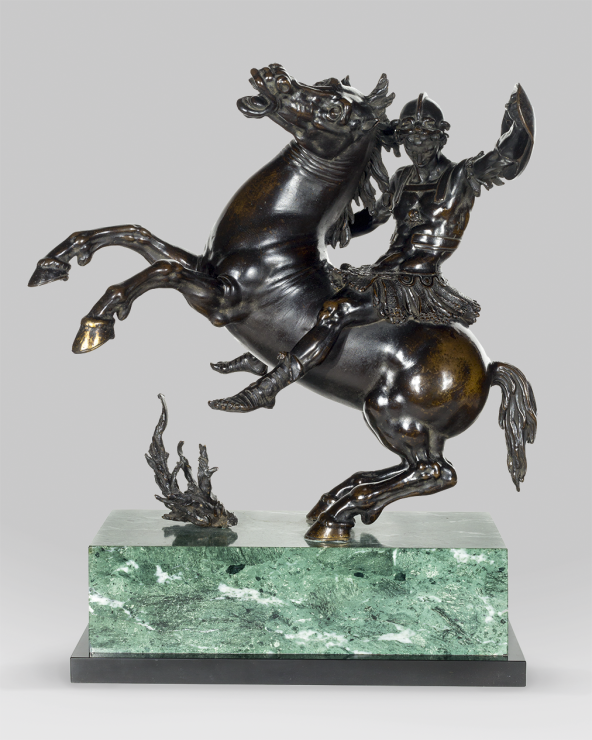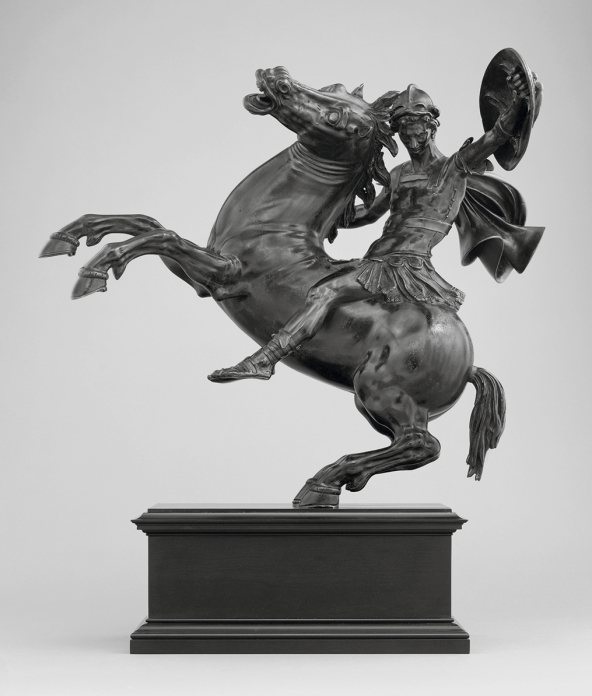Choose a background colour
Jan de Bisschop, Dutch, 1628-1671
:
Study of a Bronze Statuette, after Willem Danielsz. van Tetrode, c. 1660-70
Pen and brown ink and brown wash over black chalk, possibly with highlights in white (now oxidized) on paper.
7 3⁄8 × 7 9⁄16 in. (18.7 × 19.2 cm)
Verso of mount, bottom center, in pencil, Jan de Bisschop 15552.
- Chain Lines:
- Indiscernible.
- Watermark:
- Arms of Amsterdam.
- Provenance:
H. E. ten Cate, 1868 – 1955, Almelo, Netherlands (Lugt 533b); dealer, C. G. Boerner, Düsseldorf; Kurt Meissner, 1909– 2004, Zürich (Lugt 4665, stamp on mount); Ian Woodner, 1903 – 1990, New York; his sale, Christie’s, London, 2 July 1991, lot 219; Sheldon and Leena Peck, Boston (Lugt 3847); gift to the Ackland Art Museum, inv. no. 2017.1.4.
- Literature/Exhibitions:
Hannema 1955, vol. 1, 107, no. 179; Düsseldorf 1964, no. 4; Bremen & Zürich 1967, 79, no. 163, pl. 163; Hall 1973, 40 – 41, fig. 43; W. Halsema-Kubes in Amsterdam 1993 – 94, 403, under no. 57; F. Scholten in Amsterdam & New York 2003, 71 – 72, fig. 91.
- Ackland Catalogue:
- 2017.1.4
An amateur artist with great skill, Jan de Bisschop was an astute and enthusiastic copyist of Classical and Renaissance sculpture. This drawing, however, shows De Bisschop’s interest in the work of Willem van Tetrode, a Dutch sculptor active in the sixteenth century. It documents a tabletop-size bronze of Marcus Curtius, an ancient Roman soldier described in Livy’s History of Rome. A symbol of military valor, Marcus Curtius hurled himself into a chasm created by the gods in the Roman forum to save the city. De Bisschop’s drawing, featuring bold brushwork and his personal blend of reddish-brown ink, conveys beautifully both the rider’s fortitude and the horse’s utmost terror as they undertake their sacrificial mission.
Jan de Bisschop holds a special place in the history of Dutch art since he was not a professional artist, but rather a prominent lawyer working in The Hague. He nevertheless stood at the center of an elite circle of dilettantes who mostly drew rather than painted. De Bisschop made a significant impact on artists of his era through his drawings and etchings, and particularly through his books promoting classicizing ideals of beauty in art.1
His drawings are especially notable for their bold brushwork that makes effective use of the white reserve of the paper to create dramatic highlights, a technique he may have picked up from his presumed teacher, Bartholomeus Breenbergh (1598 – 1657). He was also famous for his distinctive reddish-brown ink, the recipe for which was apparently his own invention.2
It was mentioned as early as 1697 by Willem Goeree (1635 – 1711) in his treatise on drawing, who notes that it was made by combining an Indian ink with carbon soot and a copper-based vitriol, the effect of which lends his drawings a particular warmth and vibrancy.3
Certain passages in the present sheet have discolored over time, such as in the mane, underside, and rear of the horse, likely due to the oxidation of lead-white additions.4
Despite this, the sheet still manages to convey De Bisschop’s brilliant manner of bringing his subject forth against a dark background.
While this drawing has long been known to historians of sculpture, it does not appear in the literature on De Bisschop, for whom a catalogue of his more than 500 drawings remains a desideratum.5
His subject here is significant from an art historical standpoint because it documents a tabletop-size bronze statuette attributed to Willem Danielsz. van Tetrode (c. 1525 – 1580), an important Dutch sculptor who worked in Italy for many years, notably in the workshop of Benvenuto Cellini (1500 – 1571), before returning to the Netherlands around 1566 – 67.6
Despite being highly regarded in his time, Tetrode’s sculpture is relatively rare today, and only recently has his surviving corpus been brought more fully to light and the true extent of his influence better documented. This is the only known case of De Bisschop making a drawing after a sculpture by Tetrode. For many years, the bronze depicted here was considered a work by Dutch architect and sculptor Hendrick de Keyser (1565 – 1621) — before that, to Leonardo da Vinci (1452 – 1519), an attribution more easily dismissed — until Frits Scholten argued convincingly for Tetrode’s authorship.7
Two original casts of the bronze are extant, both in American art museums Fig. 57.1,Fig. 57.2.

Willem Danielsz. van Tetrode (attributed to), Warrior on Horseback, 1562 – 65. Bronze, height 40.6 cm. Louisville, J. B. Speed Art Museum, inv. no. 1949.30.2.
Collection of the Speed Art Museum, Louisville, Kentucky 1949.30.2

Willem Danielsz. van Tetrode (attributed t0), Warrior on Horseback, 1562 – 65. Bronze, height 39.7 cm. Los Angeles, J. Paul Getty Museum, inv. no. 84.sb.90.
The J. Paul Getty Museum, Los Angeles
They differ slightly, and only in terms of accessories: the version in the Speed Art Museum has a cluster of flames emerging from the plinth, while the Getty’s rider wears a detachable cape and bears a shield with a Medusa head image.8
The flame, cape, and Medusa head on the shield are missing in De Bisschop’s drawing. He did not necessarily draw from one of these specific examples since other casts or copies of this bronze would have almost certainly been in circulation at the time.9
In 1624, the silversmith Thomas Cruse (1586 – 1649) of Delft (Tetrode’s hometown, where he returned briefly after his travels in Italy) owned five pieces by the sculptor along with eighteen casting molds of his works.10
This suggests that Cruse and others were in the business of making replicas of Tetrode’s small-scale bronzes such as this, which must have been in some demand. The Brussels clock and gun-maker Caspar van Turckelstein (1579 – c. 1648) also made a number of replicas of Tetrode’s bronzes, though not always exact.11
Van Turckelstein’s changes sometimes included the addition of a rocky ground to the plinth, similar to the one depicted in De Bisschop’s drawing.12
Tetrode’s equestrian warrior most likely represents Marcus Curtius, the ancient Roman hero famous for his act of self-sacrifice.13
The story as set forth in Livy’s History of Rome (VII.6) recounts how a great chasm of immeasurable depth opened in the middle of the Roman Forum. According to soothsayers, this seeming admonishment from the gods could only be redressed through the sacrifice of Rome’s greatest asset. Marcus Curtius, a young Roman soldier of courage and skill, declared that Rome’s most considerable blessing could only be its military valor. Thus, riding fully armored and with his arms outstretched, he plunged headlong into the abyss which closed after him. Such moral exempla from ancient sources, especially those treating the theme of self-sacrifice, became popular subject matter in Renaissance art.14
One feature of Tetrode’s bronze, repeated to great effect in De Bisschop’s drawing, is the expression of sheer terror found on the horse, a creature understandably less enthusiastic about the leap into the abyss than its rider.
The precise identification of the subject has generally been left open in the scholarship on Tetrode.15
The flame on the plinth of the Speed’s version, however, argues strongly in favor of the representation of Marcus Curtius, in which the abyss exuding flames reflects a medieval adaptation that turned the chasm into a portal to hell.16
Several German Renaissance prints and drawings also depict flames or smoke.17
They further feature in later Dutch prints, notably in an engraving by Hendrick Goltzius (1558 – 1617) from 1586 in which one sees Marcus Curtius depicted for a second time in the background in the act of making his leap Fig. 57.3.18

Hendrick Goltzius, Marcus Curtius, 1586. Engraving, 370 × 239 mm. Amsterdam, Rijksmuseum, inv. no. RP-P-OB-10.340.
Rijksmuseum, Amsterdam
Although compositionally different, it is entirely plausible that Goltzius was inspired by Tetrode’s dynamic Marcus Curtius bronze given that the printmaker was clearly in the habit of borrowing a number of poses and anatomical features from the sculptor’s works in the years 1585 – 90.19
Discovering De Bisschop’s interest in Tetrode in this era provides one of our last glimpses of the sculptor’s impact before his name and works disappeared into near oblivion until the early twentieth century. In his drawing practice, De Bisschop was an astute and enthusiastic copyist of sculpture, but his efforts were almost entirely focused on classical antiquities or works by Italian Renaissance artists. It is difficult to say whether De Bisschop was aware of Tetrode’s authorship of the bronze (or its prototype, if it was a copy), but we know that he occasionally took an interest in sculpture by Northern artists as well. Known examples include his drawings after works by Hendrick de Keyser, Frans Du Quesnoy (1597– 1643), and a recently discovered sheet after a bust by Conrad Meit (1485 – 1550/51).20
End Notes
For basic literature on De Bisschop’s art and publications, see Van Gelder 1971; Van Gelder & Jost 1985; and Jellema & Plomp 1992. His books, the Icones and Paradigmata, were published in 1668/69 and 1671 respectively.
For De Bisschop’s ink, see Van Gelder 1971, 217; Jellema & Plomp 1992, 15; and La Camera 2007, 157 – 58.
Van Gelder 1971, 217 (citing Goeree’s 1705 ed., 91). The terms Goeree used for these three elements are Oost-Indische inkt, roet, and koper-rood.
Other examples of oxidation in De Bisschop’s sheets can be found throughout his album of 140 drawings in the Victoria & Albert Museum; for which see Turner & White 2014, vol. 1, 25 – 67, no. 23, passim.
The drawing’s author was already correctly identified as De Bisschop when it was in the Ten Cate and Meissner collections, though its subject was then incorrectly assumed (not surprisingly) to be an unidentified ancient Roman relief; see Hannema 1955, vol. 1, 107, no. 179; Düsseldorf 1964, no. 4; and Bremen & Zürich 1976, 79, no. 163. For its first link with the bronze statuette, see Hall 1973, 40 – 41; further cited in the literature on the sculpture by W. Halsema-Kubes in Amsterdam 1993 – 94, 403, under no. 57; and F. Scholten in Amsterdam & New York 2003, 71 – 72.
For Tetrode’s life and works, see especially Amsterdam & New York 2003.
The early attribution to Leonardo was made in Hall 1973; later argued as a work by De Keyser in Amsterdam 1993 – 94, 402 – 03, no. 57; and then Tetrode in Amsterdam & New York 2003, 53, 118 – 19, nos. 11 – 12 (though Scholten’s proposed attribution to Tetrode was mentioned in passing slightly earlier in Jolly 1999, 135, note 54).
A third, possibly still extant, version of the bronze has the rider wearing a plumed helmet but without cape or sword (sale, Lepke, Frankfurt, 23 April 1936, lot 114); see Amsterdam & New York 2003, 119, under no. 12.
For casts and copies of Tetrode’s works after his death, see F. Scholten in Amsterdam & New York 2003, 66 – 72.
Bredius 1915 – 22, vol. 4 (1917), 1456 – 58; and Amsterdam & New York 2003, 66 – 69.
Amsterdam & New York 2003, 67 – 69.
See, for example, Van Turckelstein’s copies from circa 1640 in the Herzog Anton Ulrich Museum of Tetrode’s Hercules Pomarius (Amsterdam & New York 2003, 68, fig. 82, and 123, no. 24); and Mercury (idem, 67, fig. 81, and 117 – 18, no. 10).
Halsema-Kubes (Amsterdam 1993 – 94, 403) averred that “no clear-cut identification of the warrior presents itself,” but made the suggestion of either Perseus or Marcus Curtius.
See, however, Van Binnebeke 2003, vol. 1, 152 – 53, no. 32, vol. 2, 228 – 30, figs. 94 – 97, in which Tetrode’s bronze in the Getty is unambiguously identified as Marcus Curtius.
Berbara 2001, 152.
One can point to prints of Marcus Curtius by, among others, Master I.B. (active c. 1523 – 1530), 1529; Heinrich Aldegrever (1502 – c. 1561), 1532; Georg Pencz (c. 1500 – 1550), 1535; and Hans Brosamer (c. 1500 – 1552), 1540; as well as to a drawing by Erhard Schön (c. 1491 – 1542), 1541, British Museum, inv. no. 1949,0411.123.
New Hollstein (Goltzius), no. 167. See also the undated engraving by Willem van Swanenburg (1580 – 1612), which may have likewise been inspired by Tetrode’s bronze; Hollstein, no. 26.
See S. Goddard and J. Ganz in Williamstown, Madison & Lawrence 2001 – 02, which builds on connections between Tetrode and Goltzius established in Radcliffe 1985; and Van Binnebeke 1993.
De Bisschop made a drawing of De Keyser’s bust of Leiden burgomaster Pieter Adriaensz. van der Werff (see Jellema & Plomp 1992, 56, no. 49; then in a private collection but now in the Rijksmuseum, Amsterdam, inv. no. rp-t-2015 – 29) as well as three views of his bronze Mercury in his album in the Victoria & Albert Museum (see Turner & White 2014, vol. 1, 34 – 35, nos. 23.19 – 23.21). For his drawings after Frans Du Quesnoy, see Jellema & Plomp 1992, 56, no. 50. For his drawing after Conrad Meit’s bust, see I. van Tuinen in Boom et al. 2020, 367 – 69.
